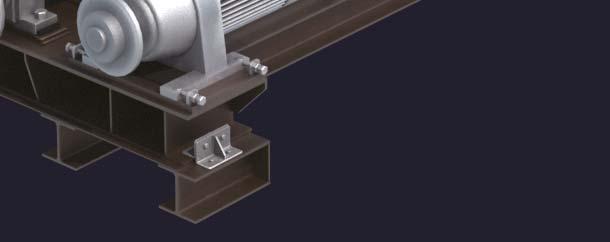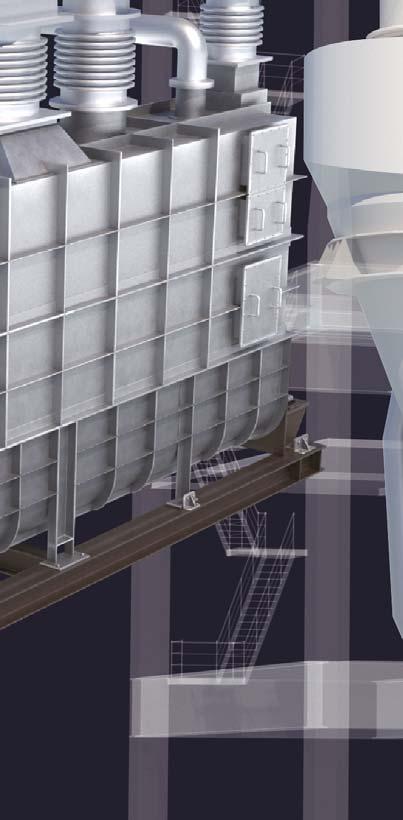
9 minute read
News
NEWS NEWS
Axians IAS completes ‘unique’ project with HeidelbergCement
“An exceptionally good cooperation and an outstandingly good result.” Those were Alexander Müller’s closing words when HeidelbergCement AG put its new Logistic Portal into operation. Alexander is the responsible and leading IAS team member for the entire VAS® roll out project for the Heidelberg Sand and Gravel works in Germany.
Together with the senior HC staff member in charge, the entire roll out team put together a unique project.
Especially in times of COVID 19, the launch of a powerful and centralised logistics solution meant a well thought out and planned execution of the project was necessary.
The initial logistics portal created specifi cally for HeidelbergCement AG went live back in 2015. The project team at that time had created an unprecedented online tool that revolutionised the entire ordering process in the bulk materials industry.
The project offered several advantages for customers. With the further development of the portal and the new challenges the project team had to face in 2020, they outperformed their former performance many times over.
The team had to deal with three areas in particular: Optimisation of automation processes especially for sand and gravel for shorter gate to gate times. Development and implementation of a special
‘all in one’ mask for faster manual handling of trucks. Development and implementation of a wheel loader application for the online and off-line case.
One of the top priorities in the project was to integrate the three challenges mentioned above into the software solution in the best possible way. Another priority was the harmonious integration, successful synchronisation and synergy utilisation of the two divisions, cement and aggregates.
This was achieved by means of a VAS template.
Due to restrictions on handling in 2020, the project team had to deal thoroughly with the following challenge: “How can we take all sand and gravel plants into operation without being on site whilst guaranteeing that everything runs well at the end?”
As part of the further digitisation and optimisation of HeidelbergCement AG, an integrated material fl ow management system will be introduced to achieve signifi cant savings in logistics costs throughout the group. Based on the existing development process, HeidebergCement AG was able to provide remote access, which enabled all plants to go live smoothly. Various plants worldwide in the cement, aggregates (sand & gravel) and cement business areas are currently being equipped with the VAS solution from Axians IAS GmbH.
UltraTech chooses AUMUND India as equipment supplier for ‘Project Spring’ expansion
UltraTech has chosen AUMUND India to supply a comprehensive equipment package comprising 22 chain bucket elevators, 46 belt bucket elevators, six pan conveyors and 11 Samson® material feeders for its ‘Project Spring’ expansion. The order is one of the largest to date for AUMUND India.
The expansion project includes three integrated cement production units, each with capacities of up to 10 000 tpd. For these kiln lines, AUMUND India will supply the critical clinker cooler extraction conveyors, well known for their reliability and availability, as well as the transfer conveyors to the clinker silos.
In addition to the clinker production lines in Madhya Pradesh, Rajasthan and Chhattisgarh, six cement grinding plants in various locations in India are part of the capacity expansion plans.
The order won by AUMUND India includes raw material handling bucket elevators, critical kiln feed bucket elevators with heights up to 157 m, and roller press recirculation bucket elevators with capacities up to 2200 tph, as well as clinker and cement handling bucket elevators of various sizes.
At the end of 2020, UltraTech decided to increase its current consolidated production
NEWS NEWS

DIARY
Hannover Messe - Digital Edition
12 – 16 April, 2021 Hannover, Germany www.hannovermesse.de

20 – 21 April, 2021 An interactive online conference focusing on reducing the cement industry’s environmental footprint. For more information, or to register for free, head over to: www.worldcement.com/ envirotech2021
IEEE-IAS/PCA Cement Conference 2021
24 – 28 May, 2021 www.cementconference.org

16 – 17 June, 2021 www.worldcement.com/ optimisation2021
BULKEX21
12 – 13 October, 2021 Chesford Grange, Warwickshire, UK secretary@mhea.co.uk www.mhea.co.uk
capacity of 116.8 million tpy by 12.8 million tpy with a mix of brownfi eld and greenfi eld expansions in the eastern, central and northern parts of India. The completion of these capacity additions will further reinforce the position of UltraTech as the third largest cement producer in the world outside of China.
Starlinger bags fi t the national standard for cement packaging in China
As China is modernising its cement production, the government has also set up a national standard, defi ning types and specifi cations of bags used for packaging cement. One of the three bag types permitted in the Chinese Standard GB/T 9774-2020 ‘Sacks for Packing Cement’, which was offi cially released in October 2020, are block bottom valve bags made of woven polypropylene tape fabric. This type of bag was invented in 1995 by the Austrian engineering company Starlinger & Co. GmbH and patented under the brand name AD*STAR.
With the AD*STAR bag, Starlinger, specialised in machinery for woven plastic packaging, created a sustainable and effi cient packaging solution for cement and all kinds of dry bulk goods.
The idea behind it was to combine the advantages of a paper bag – its brick shape and suitability for automatic handling – with the tightness and fl exibility of a PE fi lm bag, and the strength and resistance of a woven PP bag. The result: A laminated one-layer block bottom valve bag made of stretched and woven polypropylene tapes.
The main assets of AD*STAR bags are their extremely low breakage rate and excellent protection against moisture. Especially in countries like China, transport and storage of cement in bags is widespread and involves a lot of transhipping and long-term storage. Loss of cement due to bag rupture or hardening in humid conditions is a big issue. Packaging cement in AD*STAR bags offers substantial savings potential in this respect: low breakage rates and good moisture protection mean that signifi cantly less cement is lost in the logistic chain. Consequently, not only environmental pollution is reduced, but also less cement needs to be produced to replace these losses, which in turn saves CO2 emissions. An independent Life Cycle Analysis carried out in 2015 showed that due to these characteristics, AD*STAR cement bags have lower global warming potential than multi-layer paper cement bags and are currently the most environmentally friendly packaging for cement.
AD*STAR bags are produced on Starlinger ad*starKON block bottom conversion lines and are available in a wide range of sizes. The company’s focus on research and development ensures that AD*STAR bags and AD*STAR production technologies are continuously improved and adapted to the needs of the market. Technological advancements and new product features such as easy-open closure or handles for carrying make the bags even more versatile and usable in different applications.








NEWS NEWS

Currently, around 15.7 billion AD*STAR sacks are produced each year on more than 550 Starlinger conversion lines installed on fi ve continents.
The new Chinese Standard for cement packaging applies to cement bags holding up to 50 kg and lists the above mentioned laminated woven plastic bags (made of one layer of laminated plastic fabric or with additional paper liner), paper bags (three-layer, three-layer with PE liner, four-layer bags), as well as paper-plastic composite bags (paper bags with plastic liner) as possible packaging options. All three types of bags must be designed as block bottom valve bags.
The standard specifi es the dimensions as well as physical and mechanical requirements of the cement bags. Regarding break resistance, for example, a cement bag has to survive a drop from a 1 m height a minimum of six times before it breaks. Furthermore, printing and marking, general bag appearance, testing methods, and rules for quality inspection during bag manufacture are established in the standard. It also stipulates that each bag must be provided with a certifi cate before selling.
By recommending woven polypropylene block bottom bags in the new National Standard, the Chinese government has adopted a future-oriented approach that aims for more sustainability in the cement industry. It curbs unnecessary loss of cement during production, transport and storage, reduces environmental impacts, improves working conditions for operators on the cement fi lling lines, and generally makes the handling of cement in 50kg or smaller units more effi cient.
It also means that the formerly widely used sewn woven plastic bags which were irregular in shape, often leaking, and problematic for automatic fi lling and handling, will no longer be permitted as cement packaging in China.
Cement companies are given a transition period until 31 March 2022 to adapt to the new standard. Due to this time limit, Starlinger’s AD*STAR conversion lines are currently high in demand in China. The company expects to deliver and install machines for an additional production capacity of more than 2 billion AD*STAR bags on the Chinese market in 2021 and 2022.
IKN makes progress on Kiln Line No. 8 for Märker Cement
New projects always begin with a fi rst step. When looking at the construction site at Märker Cement, the fi rst series of steps is already quite visible. Both the solid concrete basis for the preheater and the fi rst kiln pier have almost reached their full heights. Foundation works for the cooler building are in progress, showing the future footprint.
The new kiln line No. 8 is being built right next to the existing production line which it will replace after commissioning. The start of this important project directly in the heart of Germany and during the diffi cult COVID-19 times shows the commitment of Märker Cement towards the plant, its employees, and the region.
Cimprogetti receives orders for multiple lime hydration plants
Italy-based engineering fi rm, Cimprogetti, which supplies vertical kilns for the calcination of limestone and dolomite and complete quicklime hydration units, has received several orders for hydration plants.
Rheinkalk, a subsidiary of Belgium’s Lhoist, has placed an order to Cimprogetti for two hydration plants with a 10 tph nominal capacity for its lime plants at Regensburg (Walhalla plant) and Efringen-Kirchen (Istein plant).
The Walhalla Plant features a CIM-HYDRAX-4G hydrator mod, the fourth generation of Cimprogetti hydrator, with a customised fi lter. The Istein Plant features instead the CIM-HYDRAX-4G MAX hydrator mod, with an independent premixing stage. The hydration plants have been ordered as part of a renovation programme.
Cimprogetti also received an order from a leading Chinese Group for a 10 tph hydrating plant featuring the 5-shaft hydrator Cim-Hyrdax-TG-600. The calcium hydroxide will be used as absorbent for the FGD device located in Haimen Port area (Jiangsu Province).
The use of Ca(OH)2 sorbent allows for a reduction in the concentration of acid gases in different industrial sectors; average of 15 – 30% for HCl, 50 – 90% for SO2 and 80% for HF in certain process conditions (temperature and pressure).






